Beginner’s Guide To Cloud Computing
Cloud computing is the on-demand delivery of IT resources over the Internet with pay-as-you-go pricing. Instead of buying, owning, and maintaining physical data centers and servers, you can access technology services, such as computing power, storage, and databases, on an as-needed basis.
Why cloud computing? What are it’s benefits?
Cost savings
The cloud allows you to trade capital expenses (such as data centers and physical servers) for variable expenses and only pay for IT as you consume it. Plus, the variable expenses are much lower than what you would pay to do it yourself because of the economies of scale.
Elasticity
With cloud computing, you don’t have to over-provision resources upfront to handle peak levels of business activity in the future. Instead, You can take advantage of auto-scaling to scale these resources up or down as your business needs change.
Go global in minutes
With the cloud, you can expand to new geographic regions and deploy globally in minutes. You can deploy your application in multiple physical locations with just a few clicks. Putting applications in closer proximity to end users reduces latency and improves their experience.
Agility
The cloud gives you easy access to a broad range of technologies so that you can innovate faster and build nearly anything that you can imagine. You can quickly spin up resources as you need them–from infrastructure services.
You can deploy technology services in a matter of minutes, and get from idea to implementation several orders of magnitude faster than before. This gives you the freedom to experiment, test new ideas to differentiate customer experiences and transform your business.
What are the Cloud Computing Deployment Models?
There are three deployment models for cloud computing: public cloud, private cloud(On-premises), and hybrid cloud.
Public cloud
Services are offered over the public internet and available to anyone who wants to purchase them. Cloud resources like servers and storage are owned and operated by a third-party cloud service provider and delivered over the internet.
Private cloud (On-premises)
Deploying resources on-premises, using virtualization and resource management tools, is sometimes called “private cloud”. Computing resources are used exclusively by users from one business or organization. A private cloud can be physically located at your organization’s on-site datacenter. It also can be hosted by a third-party service provider.
Hybrid cloud
This computing environment combines a public cloud and a private cloud by allowing data and applications to be shared between them. The most common method of hybrid deployment is between the public cloud and existing on-premises infrastructure to extend, and grow, an organization’s infrastructure into the cloud while connecting cloud resources to the internal system.
Types of cloud computing?
Infrastructure as a Service (IaaS)
Infrastructure as a Service, Contains the basic building blocks for cloud IT and typically provide access to networking features, computers (virtual or on dedicated hardware), and data storage space. Infrastructure as a Service provides you with the highest level of flexibility and management control over your IT resources and is most similar to existing IT resources that many IT departments and developers are familiar with today.
Platform as a Service (PaaS)
Platforms as a service remove the need for organizations to manage the underlying infrastructure (usually hardware and operating systems) and allow you to focus on the deployment and management of your applications. This helps you be more efficient as you don’t need to worry about resource procurement, capacity planning, software maintenance, patching, or any of the other undifferentiated heavy lifting involved in running your application.
Software as a Service (SaaS)
Software as a Service provides you with a completed product that is run and managed by the service provider. With a SaaS offering, you do not have to think about how the service is maintained or how the underlying infrastructure is managed; you only need to think about how you will use that particular piece of software. A common example of a SaaS application is the web-based email where you can send and receive email without having to manage feature additions to the email product or maintaining the servers and operating systems that the email program is running on.
Backend as a Service ( BaaS )
Backend-as-a-Service (BaaS) is a cloud service model in which developers outsource all the behind-the-scenes aspects of a web or mobile application so that they only have to write and maintain the frontend. BaaS vendors provide pre-written software for activities that take place on servers, such as user authentication, database management, remote updating, and push notifications (for mobile apps), as well as cloud storage and hosting.
PaaS Vs BaaS
PaaS does not include pre-built server-side application logic, such as push notifications and user authentication. PaaS offers developers more flexibility, while BaaS offers more functionality.
Function as a Service ( FaaS )
FaaS is a part of the serverless microservice architecture. FaaS lets developers write and update a piece of code on the fly, which can then be executed in response to an event, such as a user clicking on an element in a web application. This makes it easy to scale code and is a cost-efficient way to implement microservices.
In case you want to know about BaaS and FaaS
Examples of IaaS, PaaS, SaaS, BaaS, and FaaS
Which are the major cloud service providers?
Some of the major cloud service providers are Amazon Web Services (AWS), Microsoft Azure, Google Cloud.
Start your cloud journey with these free courses
AWS Cloud Practitioner Essentials
https://www.aws.training/Details/eLearning?id=60697
Microsoft Certified: Azure Fundamentals
https://docs.microsoft.com/en-us/learn/certifications/azure-fundamentals
Getting started with Oracle Cloud Infrastructure
https://learn.oracle.com/ols/home/oracle-cloud-infrastructure-learning-subscription/35644#filtersGroup1=.f1778%2C.f1783&filtersGroup2=&filtersGroup3=&filtersGroup4=&filtersGroup5=&filtersSearch=
Reference
https://docs.microsoft.com/en-us/learn/modules/intro-to-azure-fundamentals/what-is-cloud-computing
https://aws.amazon.com/what-is-cloud-computing/
If you like my article feel free to share :)
